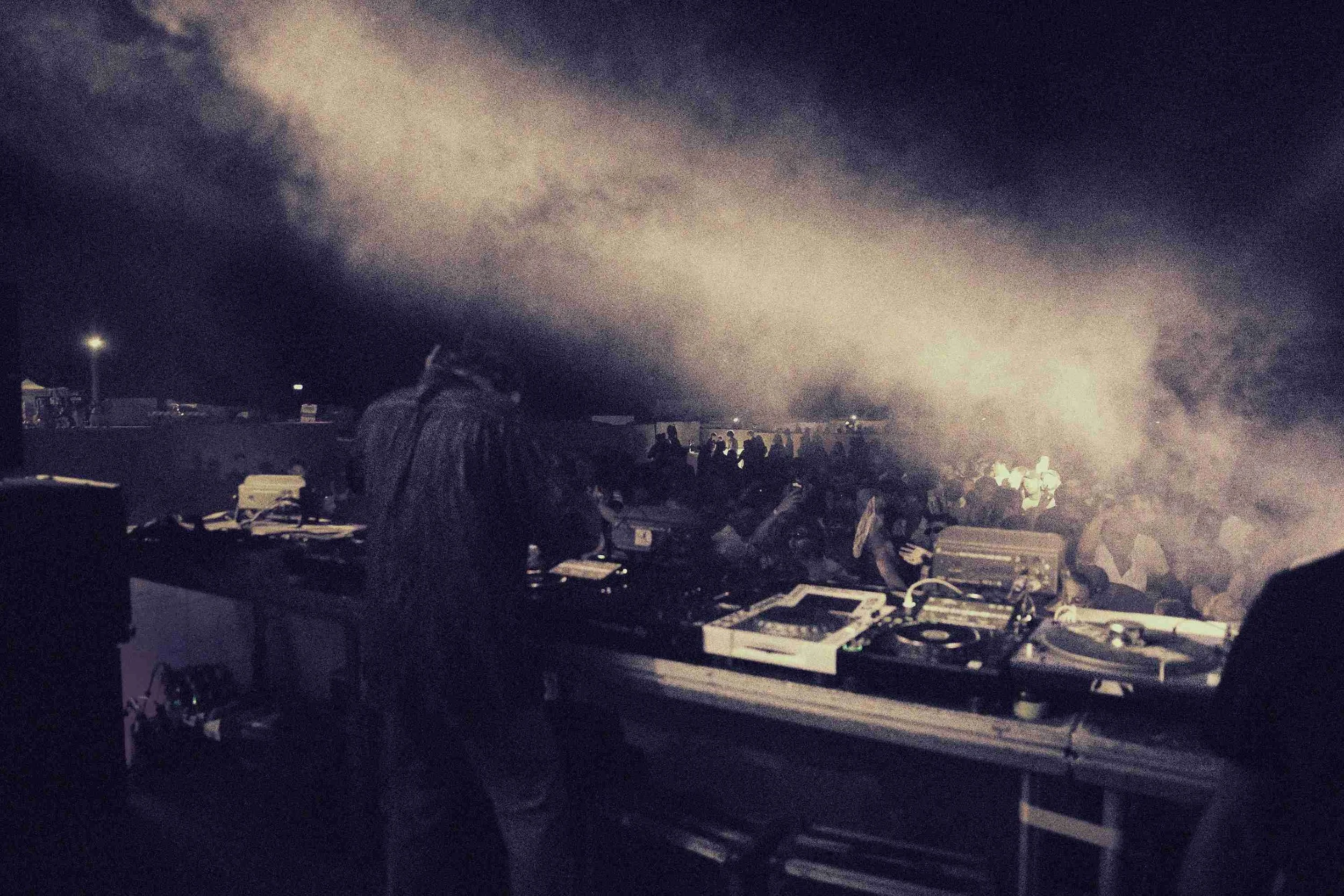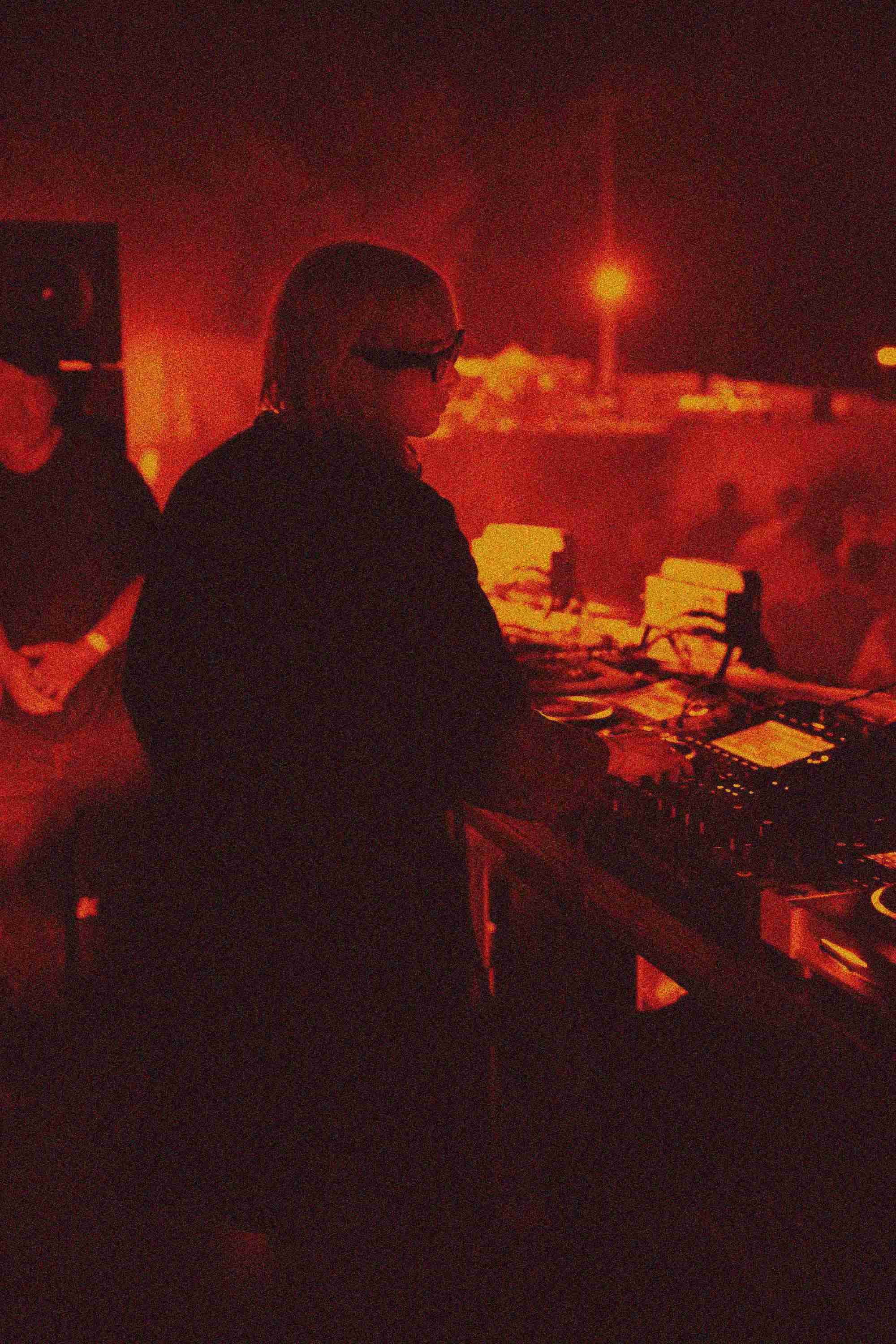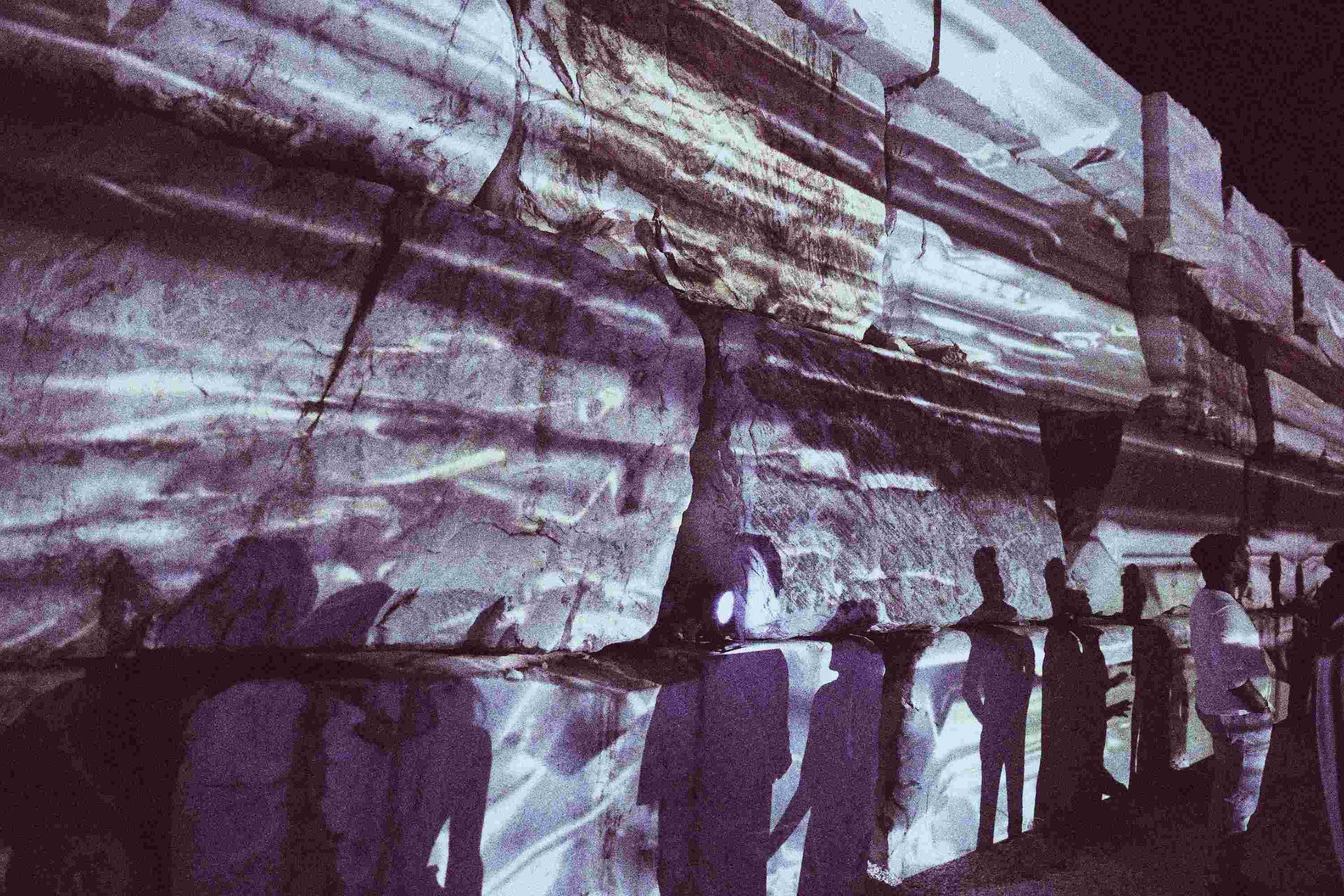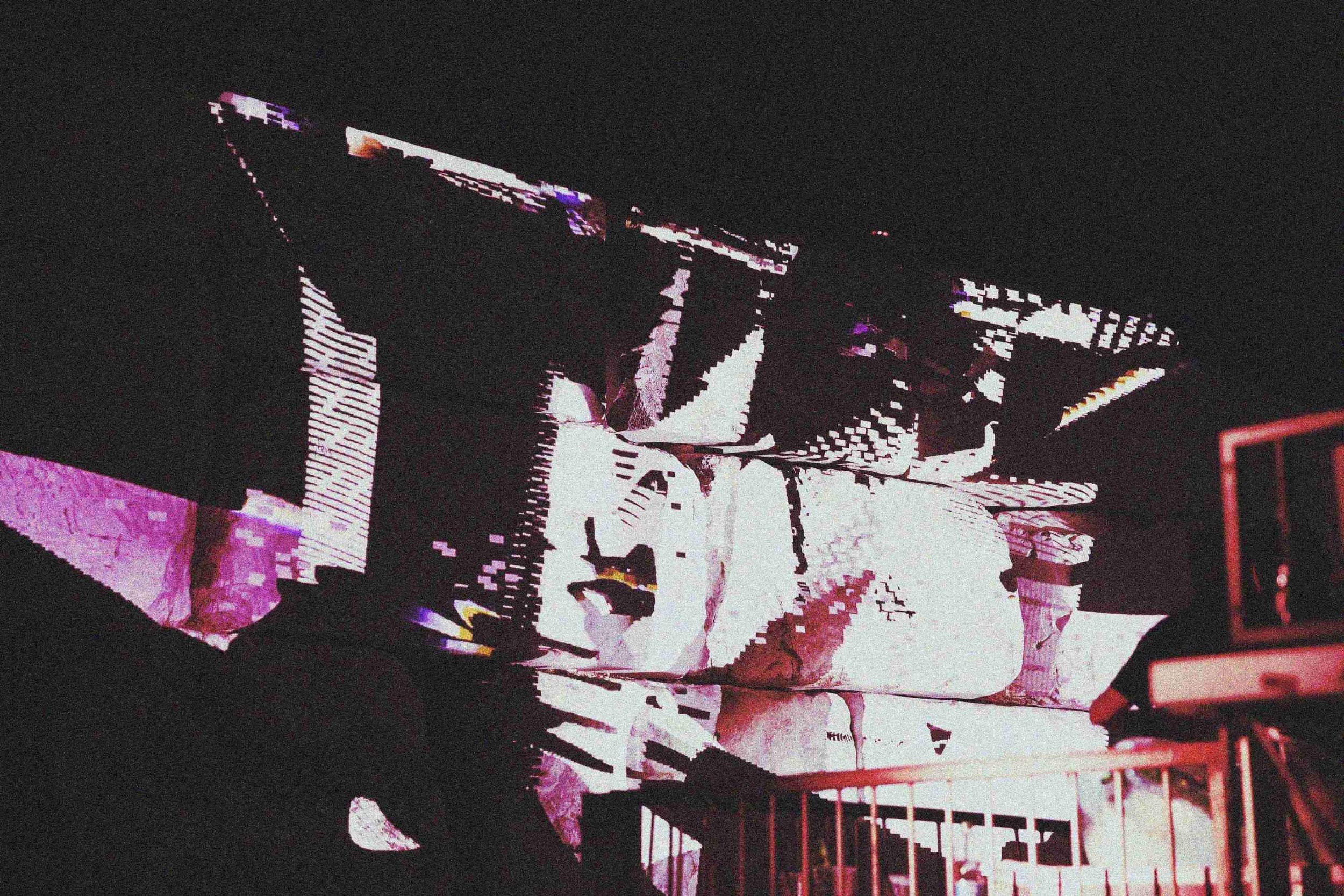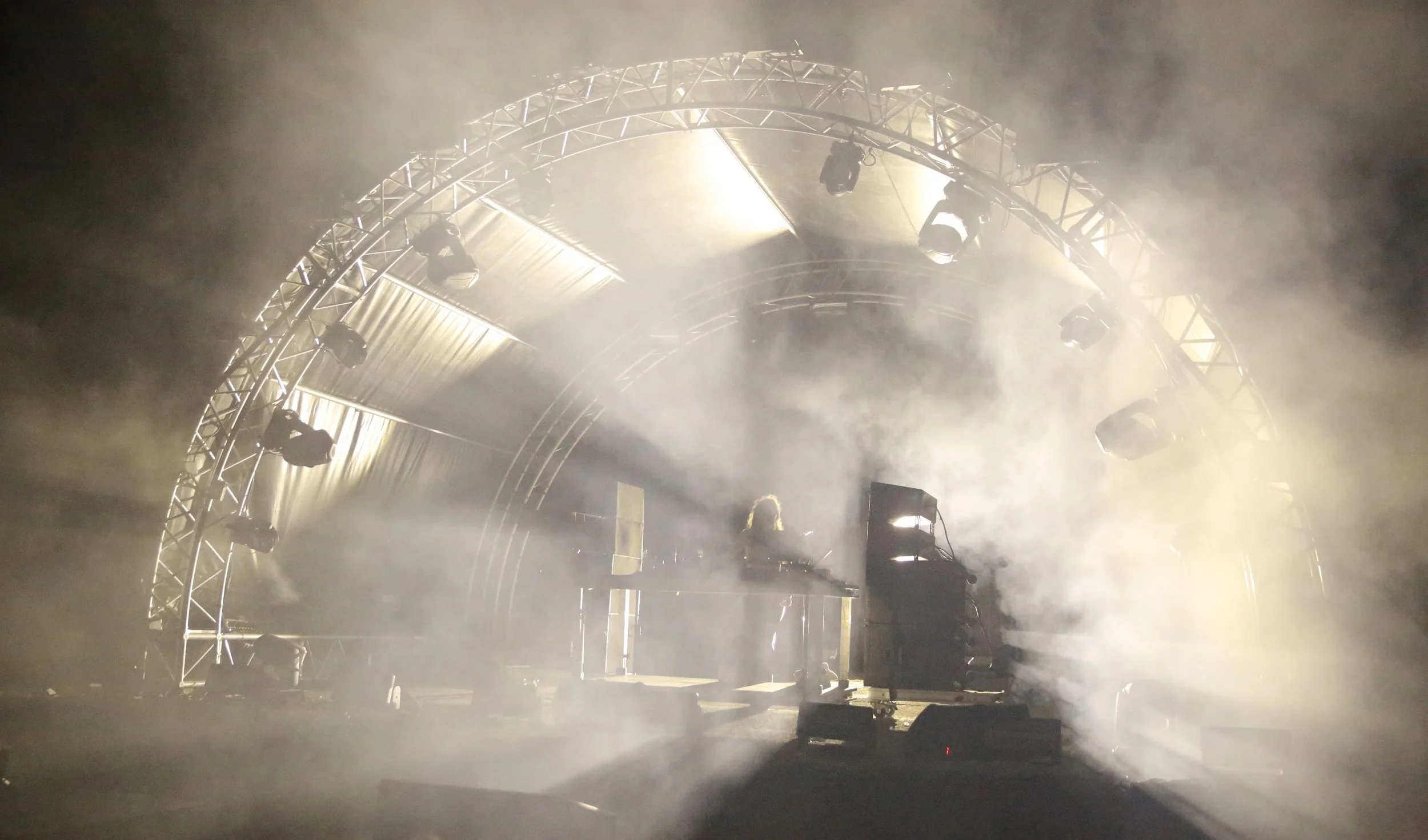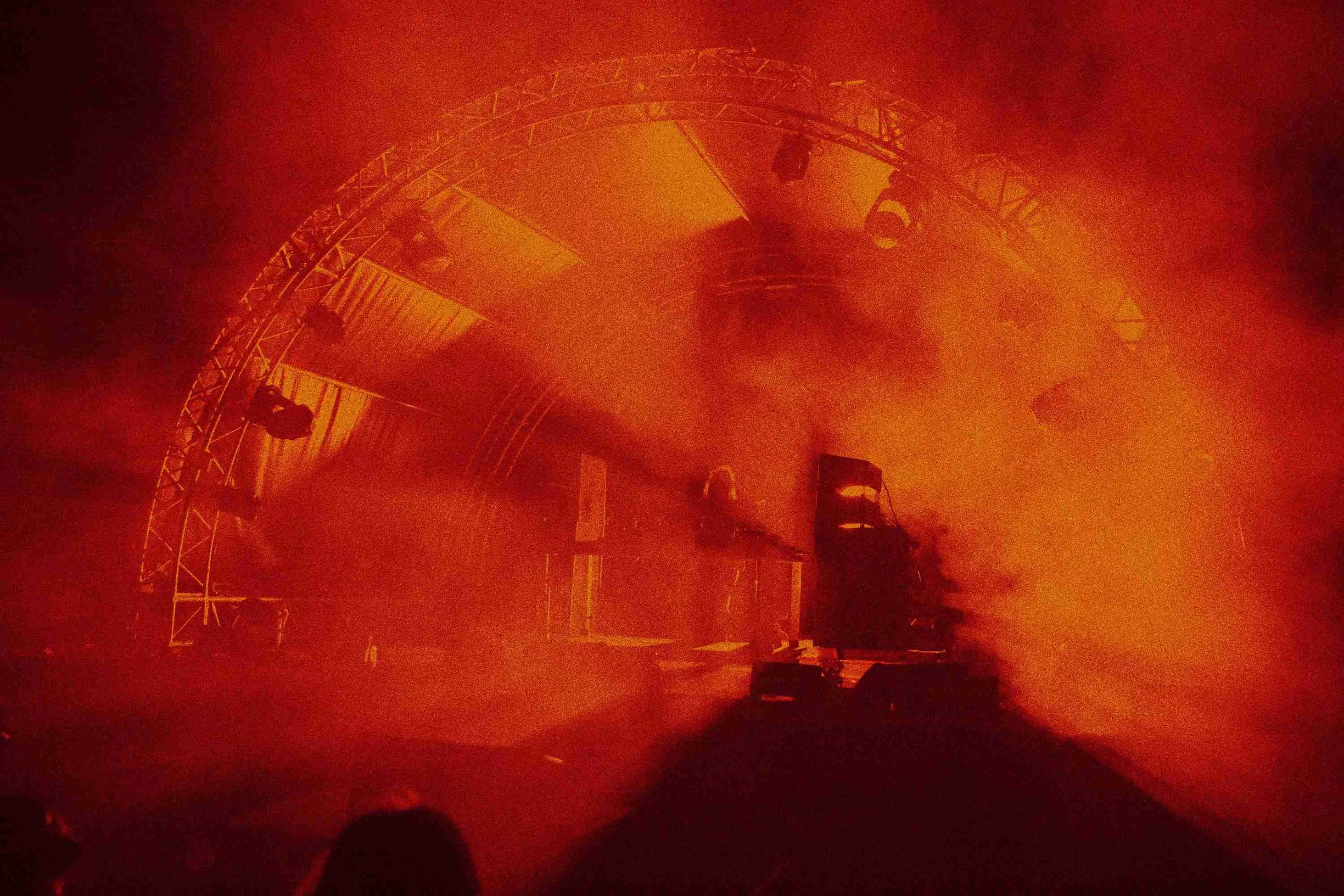Vox Marmoris Festival 2024
Photo by @leobert
Set against the stunning backdrop of Carrara’s white marble quarry, we experienced two nights of heart-wrenching electronic music and mind-blowing video mapping. The two long nights of July 26 and 27, from 9pm until morning, saw an original succession of international and Italian names.
A touching show, which immerses itself in local tradition and charging us for the beginning of summer. A fusion of humans, ancient materials, algorithms, surreal ambiances and high BPMs that turned into emotional landscapes. The daytime program had us discussing technology, algorithms and the latest in artificial intelligence. The voice of the marble quarry told us more than I ever expected.
Vox Marmoris, a festival in the world’s most iconic marble quarry, where we’ll dance to electronic beats in a natural amphitheater lit up by laser visual art—sounds irresistible, right? Every element is perfectly in place.
Here, sound meets art, craftsmanship meets science and tradition wraps it all in a warm embrace that makes you feel right at home. Upon arriving in Carrara, we're struck by the blinding white gash of the Apuan Alps, towering over the Versilia landscape all the way to the sea. These mountains echo centuries of carving and extraction, of artists covered in the purest white dust in the world with a grain “so fine, homogeneous and crystalline that it resembles sugar”.
On the first evening, we’re embraced by the timeless early-summer atmosphere in the heart of Carrara, wandering through the steep alleys—marble above and below us—dining at a cozy trattoria and greeting the elders in anarchist circles, all during the White Carrara design event. Then, it’s time to head up to the quarry.
On July 26th and 27th, 2024, from dusk till dawn, the seventh edition of the Vox Marmoris festival will bring the quarry to life, giving artists a “voice” as it immerses itself in the city and spreads across historic sites, allowing us to dance and explore the town on foot: the Sculptors' Cooperative, Torart Factory, the MudaC Museum, the Marble Depot “Successori Adolfo Corsi,” the Vox Marmoris Arena, Palazzo Binelli, and the Civic 1 Art Gallery.
It’s all part of a cohesive whole, aiming to bring a wind of cultural transformation to the area through multimedia arts, offering high-quality experiences. The festival charges into this stunning setting at full throttle, living up to every expectation. As night falls, the Marble Depot “Successori Adolfo Corsi” (Strada Comunale per Colonnata) transforms into a stage like no other, perched high in the quarry, complete with a long white bar and a vast, sparkling dancefloor. We danced, getting covered in white in the open-air quarry that resembles an amphitheater, sipped drinks on blocks of metamorphic marble, stumbled over excavators moving the blocks, touched the diamond wire, explored the depot at 500 meters above sea level and watched the mountains light up with LEDs and visual art, until we were dazzled by the marble at dawn.
A unique setting, convergence of laser lights and marble sparkle.
The challenge of this year’s festivals has been, in some respects, the choice and cohabitation with the location. The location becomes, in many event-design proposals, the main guest, suggesting how and why it should be listened to—the red thread connecting the entire thought behind it and the first element of charm. But why the focus on location? Because it’s all about the synergy and vision between art and nature, sidestepping overly complex ideas or artificially innovative mixes. It all starts with the resources at hand, the land we live in, and what we’ve “got in the family.” We work within the perimeter of marble blocks arranged to amplify the sound and light effects of the show: the blocks around the massive dancefloor aren’t always moved for the event—they’re left as the quarry workers placed them. We’re guests, plain and simple. With video mapping, top-tier electronic music, and depth-defying visuals, the intent is to harness the power of a unique location—these marble quarries—blended with the easygoing vibe of summer.
It’s a culture of “festivity”, light and seasonal, that grows and adapts to the mountain and its ancient, ever-changing, undefined composition. Discovering how a place doesn’t reject us, how to be respectful tourists, and experiencing something truly “elite.” We’re in a place with its own magic, where tradition remixes itself stress-free because it has nothing left to prove.
The allure of the material remains in style! “The marble is already complete. Inside it, the figure is already contained; I just need to remove the excess” – in Michelangelo’s words
Marble working in this area has ancient origins: the actual extraction dates back to Roman times, between 89 and 48 BC. The word marble, from the Greek verb marmáirein, means “to shine”—referring to the bright and lustrous appearance of the material, calcium carbonate deposited over ages from the limestone of algae and aquatic animal shells.
Everyone's got a part to play in the global soundscape—a vast, ever-present musical composition surrounding us. We seek a break from the metropolitan noise, escaping to a distant place where we can truly listen. Vox brings together artisans, blending the craft of art and music with the latest in algorithmic and technological research with an international flavor. This guides us through the daily dimensions of the local landscape and its people, with the festival’s musical orientation firmly rooted within the cutting-edge experimental music industry.
We contribute to the discourse on authenticity and extraordinary experiences by redefining the everyday nature of tourist destinations, proving that not all music festivals need to be "extraordinary" events. Sometimes, taking things a little lighter is just as impactful.
For one weekend, the Corsi family quarry, active since the 1800s, transforms into a shared space for arts, music, visual clubbing, and visual arts. Since 2011, artistic director Giulio Corsi, attuned to the contemporary soundscape and dj culture, has brought this idea to life, making “home” a container of sounds and connections between individuals, art and landscape.
This early summer fest, reflected in the diversity and intensity of the artist lineup—ranging from Daniele Baldelli with italo disco to Max Cooper’s refined sound and visual engineering—creates a captivating and relaxed environment (watch where you park to avoid scratching your car!). The music harmonized perfectly with the surroundings, presenting a varied and never banal lineup, featuring moments from great artists that were truly moving. I appreciated the musical variety, where even the nature itself felt ambient, coupled with the low-voltage bpm techno—topped off by a simil-psytrance touch on the final night, the cherry on top! The music and location were curated with the passion of those who know, love, and live in the place.
Brothers Giulio and Olivia Corsi uphold the family tradition and, from this, build a unique creative concept each year, no small feat given the conservative tendencies of small towns. The international element is crucial—elevating the soundscapes especially through visual and multimedia experiences, creating a narrative path through the city of Carrara, invading its historic buildings and museums. “Our company has cultivated marble for over two centuries, combining tradition and innovation, respecting the land while increasingly embracing the digital future. These will be nights of technology, art, music, and magic”.
The centuries-old, traditional and artisanal aspect is strongly reflected in Vox’s summer festival offering, which draws a broad audience and definitively kicks off the summer season. It’s a prelude to the great escape and the sonic awakening from the daily overload of information and the frenzy of everyday life. It’s the perfect way to enliven museums and palaces, with conferences touching on artistic practices that intertwine with history and tradition. In the quarry, a joyful, relaxed human ecosystem echoes, coexisting with the mountain and moving under the stars.
Among the public program’s external works, all revolving around the generative concepts of technology, marble tradition, and sound science, are “Amnesia” by Cristian Rizzuti and Julian Alvárez, the marble sculpture created by a robotic arm “Fighters” (I Lottatori), the video of the same creation “Fighters X Palestrina Sicut | Seme” by Quayola, with sound collaboration by Cooper’s harmonies.
All of this is made possible thanks to the long-standing collaboration with the municipality of Carrara.
We immerse ourself in the emotional content of a set that takes its time, expanding within the context. The territory is given a voice, tradition is illuminated, and the people come alive.
Vox Marmoris by night – the emotional, pumping and melancholic sounds in the quarry
Line Up
Day 1
Vox Marmoris soundystem
Daniele Baldelli
Danilo Plessow / MCDE Dj Set
HAAi
Day 2
Martina Potente
Max Cooper 3D AV
Donato Dozzy
The Quarrier
After the climb and parking the car in the white quarry—already a magical experience—we're surrounded by lights and sound in a lunar atmosphere. The lineup is continually enhanced by live visuals, site-specific laser performances and interactive live mapping through the use of TouchDesigner.
Immersive audiovisual installations that transform the mountains include “Light Echoes” by Ephemeral Tomorrow (Asako Fujimoto, Maxime Lethelier, Riccardo Torresi) and Visual Artist O. Ephemeral Tomorrow is a Berlin-based art collective that blends science, tech, and art. Through the aesthetics of light and sound, the group reflects on the meaning of space and the universe, studying the scientific mechanisms of remote sensing in both technical and artistic applications. For Vox, they studied the seismic activities of the Carrara area from the 90s to today, projecting the rhythms onto marble in real-time through lasers, creating "shared vibrations" between humans and technology. These three artists, with diverse backgrounds —Torresi in architecture and generative media art, Fujimoto, a Japanese composer who also works with algorithms and voice, and Lethelier, a French artist known for transmedia and theatrical installations— are all captivated by the monitoring of time in space, space stations, orbital movements and the ethereal connections between stars. They’ve worked for various clubs, mapping them with site-specific and live-generated projections.
On the first evening, Saturday 26th, from 9pm till morning, we’ll experience an international sonic mix, starting with Daniele Baldelli, an iconic italian dj who has been "spinning records" since the 70s during the golden age of pre-electronic disco music, getting the kids dancing on the floors of the Riviera Romagnola. He began with 45s at the Tana Club in Cattolica in '69, launching the Afro Cosmic Disco sound characterized by funky sonorities, heavy use of synths, and African drums, "a mix of trippy rock and tribal percussion," paralleling the Italo disco mainstream at the time. He’ll get us dancing lightheartedly, summery, and totally relaxed, all while he effortlessly handles his weapons of choice.
Next up is Danilo Plessow, a hot name on the european electronic and analog scene, an eclectic connoisseur of turntables, of which he’s an obsessive collector. A young talent with an impeccable reputation as an unpredictable remixer of samples, he’s a producer with meticulous care for every single sound, exclusively crafted on analog gear. Known as Motor City Drum Ensemble, under which he released Raw Cuts, he hails from southern Germany and later moved to Stuttgart. His latest records are a mix of ambient, contemporary jazz, house, and dub techno seamlessly fused together. He’ll offer a fresh, good-humored, and carefree set that will have us dancing alongside him. "Drums and groove are vital to music; I generally like rhythmic stuff".
Then comes the invigorating beat of HAAi, recharging us with time changes and bouncy, submerged vocal fragments, An energy that both rocks and soothes us. Her slowed and nebulous vocal sample, along with noisy pauses, transforms late night into early morning. Aka Teneil Throssell, a London-based Australian-born artist, she produces electronic records that range from breakbeat, techno, and the deeper, dub corners of British bass music, all with a sly sense of humor. The album “We're Ascending” features a track produced with Jon Hopkins, with whom she shares ambient roots, recreating existential transcendence in a video where psychedelic birds dance to a trance rhythm and vocoder loop, all reconnecting with Mother Nature. She’s worked with Fred Again and Kylie Minogue and aims to "move with the world, which keeps turning even when you stand still". Those who stayed in the quarry until morning recount hearing the first excavators of the day begin their noisy work.
Martina Potente kicks off the second evening, a North Italian DJ born in 1995. Her approach to clubbing is deeply rooted in the underground electronic music scene, drawing heavy influence from the sets of Detroit and Chicago.
Max Cooper: molding an emotional visual narrative using sound.
Max Cooper delivers a total, mind-blowing experience—completely and beautifully surreal. He keeps peeking back at the A/V show behind him, dropping sounds that echo the melancholy of a place and vibrate with its poetry. His music is built to be surreal in a real space, creating emotional zones, emotional spaces, and elegantly dramatic nostalgia.
Max Cooper, born in 1980, grew up in Belfast and now works in London as a DJ and producer. He holds a Ph.D. in Computational Biology from the University of Nottingham.
His music is intelligent, capable of narrating the minutiae of human life in its tiny scale compared to the vastness around us. He transforms cybernetics and electronic dystopia into something cellular, biological, with a human heart. His audio-visual pieces are complex conceptual systems that speak of time and space as uncertain scientific dimensions, rewiring the infinite digits of Pi and mathematical formulas. It's a music of consciousness that, when paired with visuals, creates a childlike, melancholic and instinctive narrative—so spontaneous and harmonious that it's impossible not to get emotional. One moment calm and balanced, the next chaotic and frayed, his sounds flow like water in a stream, like a falling star. The visuals have a dystopian, sci-fi, otherworldly, hyper-colored touch.
In his productions, the image comes before the sound. The visual structure, as he calls it, is a link between aesthetics, two ingredients that give life to the process of "emotional mapping," patterns capable of awakening the unconscious—in a symbolist key. What can we feel now that we couldn't before? With him, we forget where we are and why we're here. Cooper needs time for his sets, which harmonically traverse time to maintain coherence.
In his youth, he juggled a dual life as a part-time dj, playing at night while working as a genetics researcher at University College London. A grueling double life, producing vast amounts of material and releasing several EPs since 2007 on labels like Evolved Records and Traum Schallplatten. Cooper is well-versed in combining hardware and software techniques but doesn't depend on complex systems—the machine is merely a tool for executing useful synthesis operations, not something that should constrain sound and forms of expression. Using a generative approach, the machine's behavior remains only partially controllable.
He played at COP26 and last year he became the first techno artist to perform at the Acropolis in Athens, Greece. He founded Mesh, his label, in 2016 as a platform to explore art, music, and science, and as a research community of programmers and scientists working not just on the aesthetics of algorithms and video-sound but also on architecture, spirituality, cinematography and space science. Always interested in the aesthetics of nature, Cooper tells geological stories on a human scale: spatial audio, for instance, is rapidly being studied as the starting point for generative images. Max's recent work reflects on the limits of human language and its confrontation with AI ("a magical device for new languages"), the mysteries of consciousness and the future of music.
His music is a mix of trance, ambient, techno, and drum'n'bass with a classical touch influenced by his parents' passion, all styles connected by emotional content. Every melodic structure corresponds to a visual scene, with chord sequences carefully crafted to convey a specific feeling. The dense network created by the various layers finds convergence on the marble, on its shine, and on the images that appear on it, managed by the team at the quarry's base. Everything then slides under a single chord that harmonizes, like atmosphere or dust, every peak of sound—a chord of earth, sky and water, of brain neurons and synaptic sparks. We are bodies filled with sound, our eyes with light. The marble's voice reaches its loudest cry, malleable material surrounding us, solid and dusty. Its resonance is the context, where our echo is the text.
Basically, we’re all spellbound for nearly two hours.
https://maxcooper.net
Donato Dozzy, the evening's second expected guest, steps on stage with his calm and composed demeanor, asking for a moment of silence. Focused on detail, in both the dancefloor and the cerebral synth, his set develops slowly and, as expected, manages to move us because he draws micro-constructions that subtly alter the original soundscape, creating a magical landscape for us dancers in an imperceptible way. An atmosphere that immerses us in the vibrations of the place and the material, hypnotic music that doesn't lose rhythm or bpm—dancing. Acclaimed in deep techno circles, he fascinates with his complex minimalism and hypnotic, vaporwave-like bases that feel distant and suspended in time. He harmoniously integrates into the venue's enigma with loops and progressive accumulations of energy. The direction he takes the night, now illuminated only by stars and visuals on the mountain, is nothing short of thrilling.
He's been involved in the project “Il Quadro di Troisi” since 2020, a trio formed with Eva Geist and Pietro Micioni, one of the most significant Italian pop albums of recent years, a collection that translates decades of the country's musical history and a maestro into symbolist and surrealist soundscapes. The project draws inspiration from their classic Italo disco and synth-pop heritage, attempting to concretize a nostalgic interiority with lyrics that function as monologues. With Max Cooper, he will perform an energetic and graceful back-to-back set.
https://www.ilquadroditroisi.com
The night concludes with Giulio Corsi, aka The Quarrier, who wraps up his festival, having fun with us to house and disco vibes until the early morning. The final goodbye is to the quarry, already beginning to shine under the first rays of sunlight.
Public Program: involving robots and marble, interactive installation and dialogues with artists
The expansive programming in Carrara, from the 24th to the 27th, was an essential complement to the main event, enriching it with layers of culture. It provided me with an opportunity to discover the city and its artisanal traditions in a condensed timeframe, map in hand.
Throughout Carrara’s historic center and surrounding areas, venues such as La Cooperativa Sculturi, Torart Factory, the MudaC Museum, Palazzo Binelli, and Civico 1 Art Gallery served as the chosen sites for the public program—moments of connection and exchange, featuring conferences, talks and installations.
At Palazzo Binelli, the program kicked off with the discussion “Beyond the Visible: The Art of Interactive Installations” featuring Ephemeral Tomorrow and O. aka Olivia. They delved into the aesthetic potential of light and the visual development platform TouchDesigner, which is used for real-time interactions and was crucial to the visuals of the “Light Echoes” event in the quarry (discussed above).
On Saturday 27th, we met artists Max Cooper and Davide Quayola, who presented their work for Vox Marmoris in dialogue with Robotor. The talk, titled “Digital Metamorphosis: From Software to Sculpture,” offered insights into their collaborative and imaginative process.
Back at Palazzo Binelli, Cristian Rizzuti and Julian Álvarez introduced “Amnesia”, an immersive installation hosted at Cooperativa Scultori, a marble lab dedicated to nurturing the next generation of sculptors eager to learn the craft and understand the Carrarese spirit of “feeling the mountain” to extract its white gold. “Amnesia” is a “performative painting in seven acts”, an installation by Cristian Rizzuti, who draws inspiration from science, mathematics, and human perception, in collaboration with Julian Álvarez, a musician, composer, and physicist from Barcelona. Álvarez has not only performed at major festivals but, as a scientist, has worked on acoustic projects at Arau Acustica Studio, in collaboration with architectural studios across Europe. A generative laser projection on chemical paint circular canvas, the installation transforms light into color, creating “memory dances” in real time with phosphorescent pigments and UV lasers. The poetic reflection revolves around memory, conceived as a generative concept and condensed into metamorphic geometric figures—truly performative paintings. Each performance concludes with the final interaction of light with the canvas, with the image gradually fading over time. Memory becomes a place, an image that pulses, then a sound, only to return to the eye in an infinite cycle. Silence itself is already a memory.
Davide Quayola and the algorithmic sculpture “Fighters”: re-coding Marble with human mind and robotic arm
Roman artist Davide Quayola brings a fresh perspective to Vox Marmoris with his latest robotic sculpture, a piece that delves into the poetry of algorithms and the timeless beauty of marble. Quayola has previously exhibited at Carrara’s MudaC, showcasing polyurethane foam sculptures inspired by the unfinished works of Bernini and Michelangelo (“Pluto #F_03_S4” and “Pluto and Proserpina Frieze #l_01”). For years, Quayola has been exploring the tension between opposing forces—the real and the artificial, the original and the replica. What traces of humanity remain in what is created by a machine? How does this new relationship between creativity and robotics manifest? How does the artist's mind become the director of cybernetic machines, producing art in the classical sense?
At Torart Factory, Quayola presents “Fighters” (I Lottatori), an algorithmic marble sculpture inspired by Michelangelo’s “Prisoners” (1510-1530), unfinished sculptures brought to life through a robotic arm of his design. His focus is on the study of Italy's classical artistic heritage and iconographic canons, which, rejuvenated by new technologies, documents a new machine aesthetic and demonstrates how it can become a creator of art, driven by the supreme human mind. The emphasis here is on the process itself—the computational gesture of the robotic set—which is an aesthetic of creation, documented through video and set to music by Max Cooper. The physical forms of the fighters are reduced to algorithmic data, allowing the machine to carve them anew after centuries, creating computational sculptures composed of new geometries. How do the body’s tensions shift? What elements are human, and which are digital?
The figures within the marble blocks, extracted “via di levare”, already possess a natural form, and the combination of man and machine trims the edges, bringing them to life. This extraction is carried out through sophisticated 3D scanning systems that trace the forms of classical archetypes, highlighting the tensions the ancient stonecutters sought to emphasize. The robot accomplishes what Giorgio Vasari once intuited: “Michelangelo’s unfinished works reflect the humanity of his ideas, always surpassing the ability of his hand”. In both art and technology, the creative faculty is born from dissatisfaction, from the inability to find in real life the concept generated by the mind. The observer in front of the unfinished work is compelled to imagine it, just as in front of technology, one strives to understand where it could go, or what one might want it to achieve. The sense of incompleteness, further accentuated by the music, ties back to a restless character, constant searching, and perpetual disturbance. The two opposites—the conceptual subtraction in sculpture and the cultural and musical addition of over-sharing—are at play.
Exposure is no longer just a “fight” of bodies, but the daily struggle between the digital and the human, between mind and machine, which must find a new balance to coexist effectively on this planet. The ancient marble, without resistance, allows itself to be delicately carved by the mechanical arm, revealing the hidden power within. We live in the century of algorithmic logic: what remains unique, indispensable, and inimitable about the human mind?
The film “Fighters x Palestrina Sicur | Seme” by Quayola e Cooper
Our tour wouldn’t be complete without a stop at MudaC, the Museum of Contemporary Arts, nestled in the heart of Carrara. Among its treasures are Fabio Viale’s mind-bending marble boat “Ah Galla II” (yes, it actually floats) from 2008, Yuri Ancarani’s film “Il Capo” (a must-see), and a Kounellis’s piece.
Here, Quayola teams up with Max Cooper to present “Fighters x Palestrina Sicur | Seme” a film documenting the algorithmic origins of the Fighters sculpture. This project invites us to reflect on the human capacity to create art in its fullest sense and consider how robotic gestures can carry the poetry of ultimate creation. In this poetic battle, how do the human artist and their cybernetic prosthesis measure up? What really sets apart a human hand from a robotic one when shaping the same material—white marble, the quintessential artistic medium?
Set to a score by Max Cooper, this work is part of his latest musical project, Seme. Originally developed for its world premiere at the Salzburg Easter Festival, Cooper’s new project draws inspiration from the passion and spirit of Italy. With Seme, Cooper looks directly at canonical Italian aesthetics, blending elements of music, science, and philosophy. The composition is hauntingly existential, echoing the Michelangelo’s “non finito” in its delicate harmonies. The expressiveness carved into marble, rendered ultra-contemporary, takes center stage—shaped by algorithms so pure they become art in their own right. Robotic precision, distant from the chaos of the human mind, finds its balance in the act of sculpting. Technology and humanity merge into a form of meditation, a spiritual act of active faith. Marble, robots, and humans—all on the same plane, beyond time. The connection between the two artists lies in their belief that artificial intelligence can write melodies and create art. Yet, it’s not as simple as “clicking a button to generate something authentic”. As in music, and in science, human creators remain the future of discovery: “Music and art, in general, are fundamentally about human expression and communication, and if there’s no human on the other side, then I think something is lost: it’s not as engaging for me”. — Cooper.
https://maxcooper.net/fighters-palestrina-sicut
Lastly, at Civico 1 Art Gallery, we encounter “Metamorphoses” by Riccardo Torresi, Andrea Polenta, O., and others. Their collaboration with White Carrara honored marble, celebrating its contemporary transformations.
//// //// //// ////
Days out of time, not just about music and dancing, but a harmonious composition of day and night, at times deeply moving. An ephemeral community renewing their “home” and tradition, sharing it with those ready to listen, see, and understand. See you soon, Vox Marmoris!
words by MATILDE CRUCITTI
photography DONALD GJOKA
What to read next


